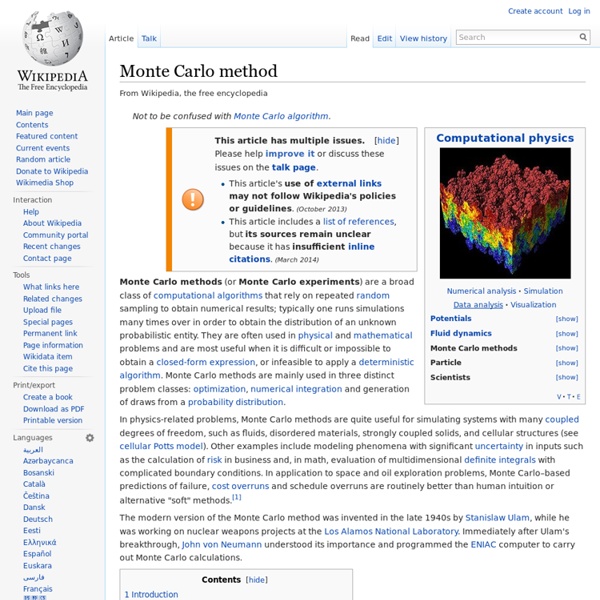Multidisciplinary design optimization - Wikipedia, the free ency
MDO allows designers to incorporate all relevant disciplines simultaneously. The optimum of the simultaneous problem is superior to the design found by optimizing each discipline sequentially, since it can exploit the interactions between the disciplines. However, including all disciplines simultaneously significantly increases the complexity of the problem. These techniques have been used in a number of fields, including automobile design, naval architecture, electronics, architecture, computers, and electricity distribution. However, the largest number of applications have been in the field of aerospace engineering, such as aircraft and spacecraft design. History[edit] Since 1990, the techniques have expanded to other industries. Origins in structural optimization[edit] Gradient-based methods[edit] There were two schools of structural optimization practitioners using gradient-based methods during the 1960s and 1970s: optimality criteria and mathematical programming. Constraints[edit] find
Doc Mitchell :: Construction & Architecture - Building Codes :: JurisPro Expert Witness Directory ::
Doc Mitchell is an expert and consultant in all types, fields, and phases of construction with the exception of nuclear reactors. Doc performed his first work as a construction expert in 1972. He has never been turn down as an expert by any court and Judges have called Doc Mitchell the best expert they have ever seen in their court. Doc can explain the most difficult construction, mechanical, or electrical items and processes to anyone in such a manner that they can completely understand it. As of this time Doc is the only construction expert in the United States holding all the following Credentials and Licenses: 1. Doc is a recognized code expert and has designed and taught numerous approved continuing educational classes for city, county and state Code Enforcement and Building Inspectors over the years. Doc’s previous cases have ranged from $ 1,500.00 to $ 50,000,000.00 For cases involving general construction or any specific construction trade please give us a call.
BBC Four - Climate Change by Numbers
Latin Hypercube Sampling | Mathieu Fenniak
Introduction Latin hypercube sampling (LHS) is a form of stratified sampling that can be applied to multiple variables. The method commonly used to reduce the number or runs necessary for a Monte Carlo simulation to achieve a reasonably accurate random distribution. LHS can be incorporated into an existing Monte Carlo model fairly easily, and work with variables following any analytical probability distribution. Monte-Carlo simulations provide statistical answers to problems by performing many calculations with randomized variables, and analyzing the trends in the output data. The concept behind LHS is not overly complex. The sampling algorithm ensures that the distribution function is sampled evenly, but still with the same probability trend. Figure 1. Figure 2. Process Sampling To perform the stratified sampling, the cumulative probability (100%) is divided into segments, one for each iteration of the Monte Carlo simulation. Grouping Example Sampling: Conclusion
matplotlib: python plotting — Matplotlib 1.2.1 documentation
Computational geometry
Computational geometry is a branch of computer science devoted to the study of algorithms which can be stated in terms of geometry. Some purely geometrical problems arise out of the study of computational geometric algorithms, and such problems are also considered to be part of computational geometry. Computational complexity is central to computational geometry, with great practical significance if algorithms are used on very large datasets containing tens or hundreds of millions of points. The main impetus for the development of computational geometry as a discipline was progress in computer graphics and computer-aided design and manufacturing (CAD/CAM), but many problems in computational geometry are classical in nature, and may come from mathematical visualization. The main branches of computational geometry are: Combinatorial computational geometry, also called algorithmic geometry, which deals with geometric objects as discrete entities. Combinatorial computational geometry[edit]
Safety Engineer Job Description, Career as a Safety Engineer, Salary, Employment - Definition and Nature of the Work, Education and Training Requirements, Getting the Job
Education and Training: Bachelor's degree Salary: Median—$63,730 per year Employment Outlook: Good Definition and Nature of the Work Safety engineers are responsible for keeping people free from danger, risk, or injury in the workplace. Safety engineers work in many different types of industrial and commercial companies to ensure safety in the workplace as well as in the products the companies make. Safety engineers often have other titles, such as director of safety, safety manager, or safety coordinator. Other safety engineers work with designers to make sure that their company's products are safe. Safety engineers who work for insurance companies usually provide consulting services to their clients. In the trucking industry, safety engineers review patterns of traffic accidents. Education and Training Requirements You generally need a bachelor's degree in science or engineering to become a safety engineer. In some cases engineers need to be licensed by the state in which they work.
Dr Hannah Fry: the mathematical models that underpin our sexual success | Science
What are the odds? Or how mathematician Peter Backus weighed up his chances of finding love… Just as it’s not possible to calculate precisely how many alien life forms there are, it’s also not possible to calculate exactly how many potential partners you may have. It also applies to maths student Peter Backus’s well-publicised quest to see whether there were intelligent, socially advanced women of the same species out there for him to date. 1. 2. 3. 4. 5. 6. 7. Leaving him with just 26 women in the whole world he would be willing to date. Personally, I think that he is being a little picky. I think there’s room to be a bit more generous. 1. 5. 6. 7. Almost a thousand potential partners across a city, then. But there is another issue. Strangely though, opening our minds to all potential partners seems to be the opposite of what we do when we’re single. The statistics of sex In 1996 Swedish scientists asked 2,810 people how many sexual partners they’d had. The happily ever after



